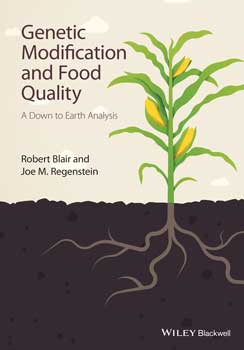Two new IFT Press books and a book review
BOOKS
IFT Press Books Cover Carotenoids, Biofilms
Two recently published IFT Press books are available from Wiley-Blackwell.
 Food Carotenoids: Chemistry, Biology, and Technology (ISBN: 978-1-118-73330-1), written by Delia B. Rodriguez-Amaya, provides a comprehensive review of all of the important information about carotenoids. These compounds, which were first identified as natural pigments, have also been studied as precursors of vitamin A and as bioactive compounds that may play a role in preventing chronic diseases. This title provides information about a variety of aspects of carotenoids, including structures and physicochemical properties, biosynthetic pathways and metabolism, analysis and composition in various foods, stability and reactions during processing, commercial production as food colorants and precursors of aroma compounds, and their bioavailability and health benefits. The book is suited for use as background information for food science, nutrition, biology, chemistry, agriculture, and medical science professionals, including those in academia, industry, and governmental and nongovernmental agencies.
Food Carotenoids: Chemistry, Biology, and Technology (ISBN: 978-1-118-73330-1), written by Delia B. Rodriguez-Amaya, provides a comprehensive review of all of the important information about carotenoids. These compounds, which were first identified as natural pigments, have also been studied as precursors of vitamin A and as bioactive compounds that may play a role in preventing chronic diseases. This title provides information about a variety of aspects of carotenoids, including structures and physicochemical properties, biosynthetic pathways and metabolism, analysis and composition in various foods, stability and reactions during processing, commercial production as food colorants and precursors of aroma compounds, and their bioavailability and health benefits. The book is suited for use as background information for food science, nutrition, biology, chemistry, agriculture, and medical science professionals, including those in academia, industry, and governmental and nongovernmental agencies.
 Biofilms in the Food Environment, 2nd Edition (ISBN: 978-1-118-86414-2), edited by Anthony L. Pometto III and Ali Demirci, expands and complements the topics presented in the original book. These include biofilm development, resistance of pathogen biofilms to sanitizers, biofilm prevention and control, and the use of bacteriophages to remove biofilms. Other chapters discuss biofilms in relation to specific food types, such as meats and meat contact surfaces, fresh vegetables and fruits, and dairy products. The book is designed to provide researchers in academia, federal research labs, and industry with an understanding of the impact, control, and hurdles of biofilms in the food environment.
Biofilms in the Food Environment, 2nd Edition (ISBN: 978-1-118-86414-2), edited by Anthony L. Pometto III and Ali Demirci, expands and complements the topics presented in the original book. These include biofilm development, resistance of pathogen biofilms to sanitizers, biofilm prevention and control, and the use of bacteriophages to remove biofilms. Other chapters discuss biofilms in relation to specific food types, such as meats and meat contact surfaces, fresh vegetables and fruits, and dairy products. The book is designed to provide researchers in academia, federal research labs, and industry with an understanding of the impact, control, and hurdles of biofilms in the food environment.
IFT Press books, developed in partnership with Wiley-Blackwell and crafted through rigorous peer review and meticulous research, serve as leading-edge handbooks for industrial application and reference and as essential texts for academic programs. Topics of future books in the series include nanoscience and nanotechnology, sustainability, medical foods, bitterness, flavor and satiety, and food packaging. IFT members receive a 35% discount on all Wiley-Blackwell books. The member coupon code is available at ift.org. Be sure to log in and check out the Knowledge Center/Read IFT Publications/IFT Press Books links for information on how to order any of the books in the IFT Press book series. For more information, call 877-762-2974 or visit wiley.com/go/ift. Manuscript proposals may be sent to David McDade, executive editor, at [email protected] (+44-1865-47-6546).
 Book Review
Book Review
Genetic Modification and Food Quality: A Down to Earth Analysis
by Robert Blair and Joe M. Regenstein (ISBN: 978-1-118-75641-6). Wiley-Blackwell.
I am a lawyer with a PhD in the law concerning risk assessment and the labeling of genetically modified (GM) foods. My undergrad was in international studies (history/economics/political science). Consequently, I nursed some trepidation about having a sufficiently robust level of scientific sophistication to “digest” this book. However, those fears were misplaced.
This book elegantly covers an extensive territory. The writing is crisp, focused, and pithy. The book is almost encyclopedic in the coverage of GM either by jurisdiction, crop, or subject matter (i.e., safety, nutrition). The coverage is sufficient as an introduction to the area, and as such, the perfect starting resource. This is not about the depth of the science; this is about the breadth of the science. Therefore, the book is a great resource for those who are uninitiated or just looking for a general reference from “5,000 feet.”
The book addresses the infamous studies that questioned the safety of GM. The narrative goes back to Pusztai, then Ermakova, and finally Séralini. More importantly, the text spells out how or why each study was impeached.
The book captures the jurisprudence and legal issues begot by GM in the U.S. case of Bowman as well as the Canadian case of Schmeiser. The book gives an overview of the regulatory regimes of many jurisdictions on all the continents. This in and of itself is fine. But there is a danger.
The Canadian regulations are viewed naturally through the prism of GM. Yet the Canadian regulations do not address GM qua GM. Rather, the Canadian regulations address the concept of “Plants with Novel Traits” or PNTs. Under the Canadian regime, the process is irrelevant in attracting regulation. It is the product that manifests the novel trait that attracts regulatory scrutiny. A similar nuance was missed with the EU regulations on labeling. The EU strictures require GM labeling on anything made with GM, not using GM. The former captures oils or corn products; the latter exempts anything made with GM yeast, etc. Trade lawyers can fight over the what and why of that distinction.
There are potentially two flaws with the book—neither is fatal and they are probably better characterized as disappointments. The first is the lack of any sort of overview of plant breeding, especially mutagenesis, but also protoplast fusion, embryo rescue, and now CRISPR (clustered regularly interspaced short palindromic repeats). This would help set the stage for the reader most likely to use this book. (To be fair, mutagenesis is cited eventually, but well into the text and necessitates a segue discussion.)
The second disappointment is the reason why GM attracts so much public opprobrium. If you are going to touch that topic—even fleetingly—you still have a lot of surface area to cover. GM is a proxy for all manner of complaint from anticapitalism, anti-agribusiness, anti-Monsanto (but strangely not its competitors), antichemical, antiscience to GM as a blasphemy against environmentalism—the new secular religion.
Why does C.P. Snow’s famous “The Two Cultures” essay still ring true today? The humanities students protest and proselytize against biotechnology, especially GM, while the science students hurry to their labs shaking their heads. Those humanities students should read this book.
—Stan Benda, Lawyer/Assistant Professor, Toronto ([email protected])
Books Received
Meathooked: The History and Science of Our 2.5-Million-Year Obsession with Meat by Marta Zaraska (ISBN: 978-0-465-03662-2). Basic Books/Perseus Books Group.
Statistics for Food Scientists: Making Sense of the Numbers by Frank Rossi and Victor Mirtchev (ISBN: 978-0-124-17179-4). Academic Press/Elsevier.
Hamburgers in Paradise: The Stories Behind the Food We Eat by Louise O. Fresco (ISBN: 978-0-691-16387-1). Princeton University Press.
Engineering for Storage of Fruits and Vegetables: Cold Storage, Controlled Atmosphere Storage, Modified Atmosphere Storage by Chandra Gopala Rao (ISBN: 978-0-128-03365-4). Academic Press/Elsevier.
Functional Foods, Nutraceuticals, and Natural Products: Concepts and Applications edited by Dhiraj A. Vattem and Vatsala Maitin. DEStech Publications.
